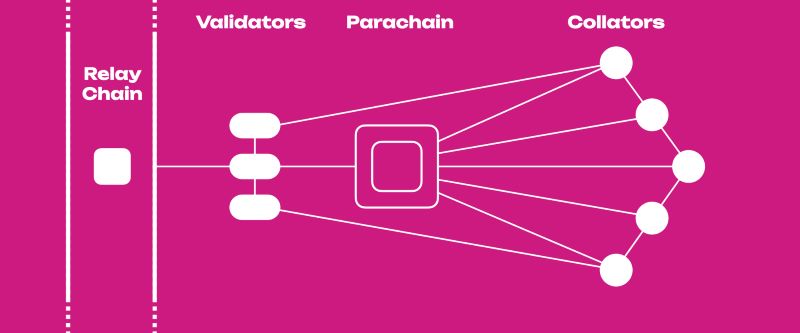Unlock the power of blockchain customization! Discover parachain development, the innovative approach that allows you to build your own blockchain within the Polkadot ecosystem. Click to learn how this technology is revolutionizing decentralized applications.
What are the Benefits of Parachain development?
Parachains are connected to and secured by the Relay Chain. They benefit from the pooled security, thought-through governance, and overall scalability of the heterogeneous sharding approach of the network. Creating a parachain can be seen as creating a Layer-1 blockchain, which has its own logic and runs in parallel within the Polkadot ecosystem.
Developers can focus on creating state-of-the-art chains that take advantage of Polkadot’s next-generation approach. Some examples of what a parachain could be are:
- DeFi (Decentralized Finance) Applications
- Digital Wallets
- IoT (Internet of Things) Applications
- Gaming
- Web 3.0 Infrastructure
The parachain model attempts to alleviate five key build failures of present technology stacks, as described in the Polkadot Whitepaper:
Scalability: How much is spent on resources and will the network be subject to bottlenecks?
Isolatability: Are the needs of many accounted for under the same framework?
Developability: Is the system tooling, system support, and overall system integrity dependable?
Governance: Can the network remain flexible to evolve and adapt over time? Can decisions be made with sufficient inclusivity, legitimacy, and transparency to provide effective leadership of a decentralised system?
Applicability: Does the technology address a burning need on its own? Is other “middleware” required to bridge the gap to actual applications?
Parachain Development Kit
The Parachain Development Kit or PDK is a set of tools that allows developers to easily create a parachain. In practice, the PDK will consist of the following key components:
State transition function : a way for your application to move from one state to another state.
Collator node network with certain responsibilities regarding parachains.
The state transition function (STF) can be an abstract way for an application to go from one state to another state. The only constraint that Polkadot places on this STF is that it must be easily verifiable — usually through what we call a witness or proof. It must be so because the Relay Chain validators will need to check that each state it receives from the collator node is correct without actually running through the entire computation.
Some examples of these proofs include the Proof-of-Validity blocks or zk-SNARKs, which require less computational resources to verify than they do to generate. The verification asymmetry in the proof generation of the STF is one of the integral insights that allows Polkadot to scale while keeping high-security guarantees.
A collator node is one of the types of network maintainers in the protocol. They are responsible for keeping availability of the state of the parachain and the new states returned from the iteration of the state transition function. They must remain online to keep track of the state and also of the XCMP messages that it will route between itself and other parachains. Collator nodes are responsible for passing the succinct proofs to the relay chain’s validators and tracking the latest blocks from the relay chain. In essence, a collator node also acts as a light client for the relay chain. For more on collator nodes, see the collator page.
What PDKs Exist?
Currently, the main Parachain Development Kit (PDK) is Parity Substrate, enhanced by the Cumulus library. Substrate offers a versatile framework for building custom blockchains, while Cumulus provides the essential tools for integrating these blockchains seamlessly into the Polkadot ecosystem. Together, they form a comprehensive toolkit that simplifies parachain development on Polkadot.
How to set up your parachain
Setting up a parachain on Polkadot involves several steps, starting with the development of your chain’s runtime logic using the Substrate framework. This logic is then compiled into a WebAssembly (Wasm) executable file, which contains the complete set of rules governing your chain’s state transitions.
Once compiled, this Wasm code is submitted to the Polkadot network for validation. Polkadot validators utilize this code to ensure the legitimacy of your chain’s state transitions. However, validators do not inherently act as nodes for your parachain, requiring additional infrastructure to maintain synchronization.
This is where collator nodes come in. These nodes are responsible for generating new block candidates for your chain and submitting them to Polkadot validators for inclusion in the Polkadot Relay Chain. While Substrate includes its own networking layer, it only supports solo chains. The Cumulus extension addresses this by providing a collator node and ensuring compatibility between your Substrate-based chain logic and Polkadot, enabling its operation as a parachain.
Future PDKs
The Web3 Foundation is interested in supporting a roll-up kit for developers to create SNARK-based parachains. This kit would utilize a model with users updating the parachain’s state and an operator aggregating those updates into a single on-chain update.
The parachain’s state transition function would handle updates from user inputs, likely using a Merkle tree for efficient verification. The operator, acting as a collator node, would aggregate the state and generate a zk-SNARK proof, which would be presented to Relay Chain validators for verification. This approach would enhance scalability and efficiency while maintaining security through the use of zk-SNARKs.
Parachain development is a game-changer, empowering developers to create tailored blockchain solutions within a secure and interoperable ecosystem. Stay ahead of the curve and explore the endless possibilities of parachain technology.
Parachain development is a game-changer, empowering developers to create tailored blockchain solutions within a secure and interoperable ecosystem. Stay ahead of the curve and explore the endless possibilities of parachain technology.


